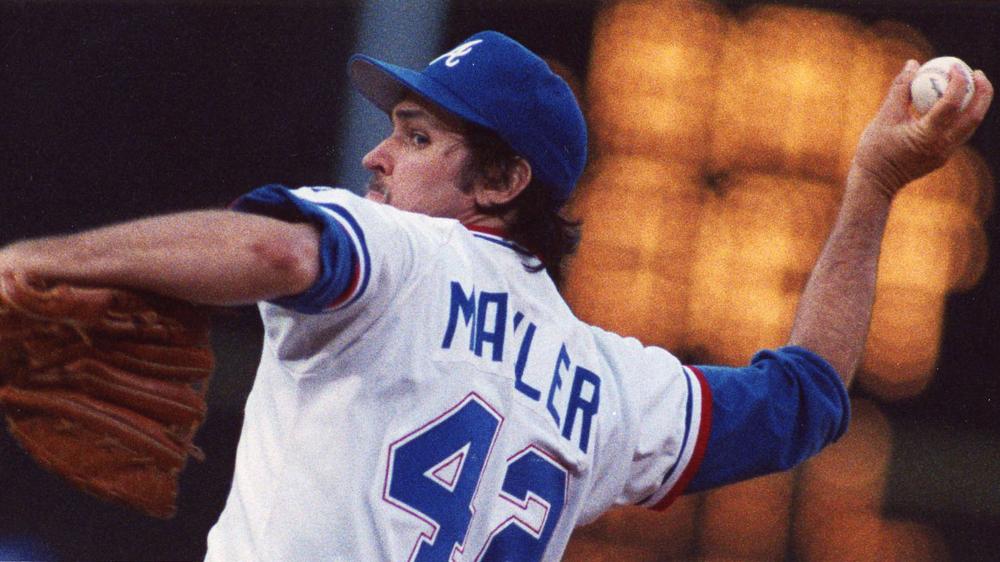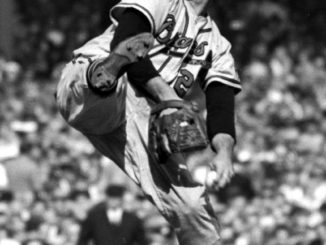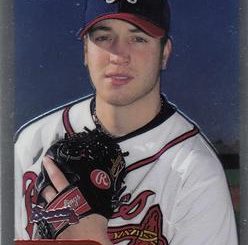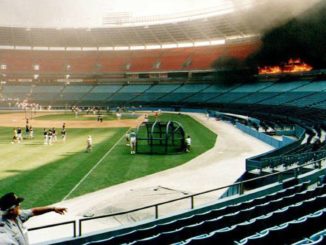
The greatest Brave to wear #42 is Rick Mahler.
Signed as an amateur free agent in 1975, Mahler’s pitching development was somewhat backwards. As he worked through the minor leagues, Mahler was predominantly a reliever. By the time he reached the majors in 1979, he had appeared in 144 MiLB games, and only 21 were starts. He bounced between Atlanta and Richmond for a couple of years, and in 1981 became a regular member of the Atlanta bullpen to start the year. By late May, Mahler had a .280 SLG allowed and a 1.59 ERA, so Atlanta moved Mahler into the rotation, and in 14 starts, he went 6-6 with a 3.21 ERA.
Mahler was an average-ish starter for the ’82 NL West champion Braves, and despite a pair of shutouts in the regular season, got only a single relief appearance in the NLCS loss to the Cardinals. He spent most of 1983 in the minors, but returned to the rotation for good in 1984.
His final five years at the Launching Pad were largely in an inning-eating role. From 1984-1988, Mahler threw 1172.1 innings, going 61-72 with a 3.99 ERA and 30 complete games. He was quite effective in the bookend years, going 13-10 with a 3.12 ERA across 222 innings in 1984 and 9-16 with a 3.69 ERA across 249 innings in 1988. In between, the runs came more frequently, but Mahler gave the Braves innings. He led the league in starts in both ’85 and ’86 (39 starts each year), and most of the bold ink on his baseball card was for leading the league in hits or runs allowed. Mahler wasn’t bad – although his surface stats in ’86-’87 aren’t great. He just played on some really bad teams. I remember Mahler from my childhood, because my father tended to relax a little more when Mahler started. He was the only reliable veteran pitcher on teams that really tested fan devotion, like the 54-106 1988 team.
Mahler’s best pitch was a big 12-6 curveball. His arsenal included other standards of the era – fastball, change, slider, forkball, and screwball (per the Neyer/James Guide to Pitching), but he was known as a curveball artist. Watch him in action here:
After hitting free agency, Mahler signed with the Reds. In 1990, he went 7-6 with a 4.28 ERA for the eventual World Champions, and though he didn’t play in the sweep of the A’s, Mahler threw 1.2 shutout innings against Pittsburgh in the NLCS. He signed with Montreal before 1991, and despite being more or less fine (3.62 ERA in 37.1 innings), the Expos released the righty in June. Mahler signed with the Braves and returned to Atlanta a few days later. After nearly two months in the bullpen for the ’91 Worst-to-First Braves, Atlanta released Mahler and his 5.65 ERA in early August. This would be the last action of his MLB career.
For the next four seasons, Mahler would serve as Minor League Pitching Coordinator for the St. Louis Cardinals under his old manager, Joe Torre. In ’96-’97 he managed the AA Arkansas Travelers. He would be pitching coach for the A- Spokane Indians in 1998, the A+ Kane County Cougars in 1999, and the AAA Omaha Golden Spikes in 2000-01. In 2002, he remained in the KC organization, now as a roving minor league pitching instructor. After a year away from the game, Mahler served as pitching coach for the St. Lucie Mets in 2004, where he tutored future Brave Scott Kazmir. He was slated to serve in the same role again when he unexpectedly passed away from a heart attack during spring training 2005.
Honorable Mention
Left-hander Steve Avery wore #33 for most of his tenure with Atlanta up through the conclusion of his career with Detroit in 2003, but his first two seasons in 1990-91 he wore #42 in deference to Mahler. Avery would have his best season as a Braves in 1991 while wearing 42, going 18-8 with a 3.38 ERA during the worst-to-first season at the ripe old age of 21 years. Avery would have the greatest NLCS performance of any Braves pitcher that same year, throwing 16.1 innings of shutout ball over two NLCS starts and helping Atlanta beat Pittsburgh by the score of 1-0 twice.
Who Was the Best Ever To Wear #42?
For real?
It’s Jackie Robinson. Mariano Rivera was pretty good, but c’mon… It’s Jackie. If you’re wondering if it’s really Jackie, reacquaint yourself with his career and make note that he didn’t make his MLB debut until he was 28. Jackie was the ultimate team player, too. After being traded to the Giants, he retired rather than play for a rival.




Leave a Reply